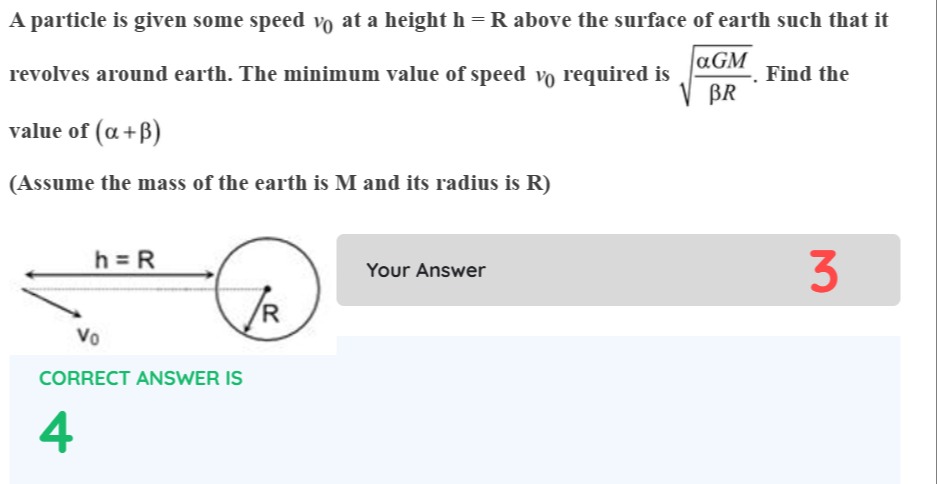Question
Question: A particle is given some speed $v_0$ at a height h = R above the surface of earth such that it revol...
A particle is given some speed v0 at a height h = R above the surface of earth such that it revolves around earth. The minimum value of speed v0 required is βRαGM. Find the value of (α+β)
(Assume the mass of the earth is M and its radius is R)

4
Solution
The particle is at a height h=R above the surface of the Earth. The radius of the Earth is R. So, the distance of the particle from the center of the Earth is r=R+h=R+R=2R.
We assume that the speed v0 is given horizontally (tangentially to a circle around the Earth). For the particle to revolve around the Earth in a closed orbit without hitting the Earth's surface, the perigee distance of the orbit must be greater than or equal to the radius of the Earth, R.
When a particle is at a distance ra=2R from the center of the Earth and has a tangential speed v0, this point is the apogee of the elliptical orbit if v0<vorbit=2RGM.
The total energy of the particle is E=21mv02−raGMm=21mv02−2RGMm. The angular momentum of the particle is L=mrav0=m(2R)v0.
For an elliptical orbit, the semi-major axis is given by a=−2EGMm=−2(21mv02−2RGMm)GMm=RGM−v02GM. The distances of apogee (ra) and perigee (rp) are related to the semi-major axis (a) and eccentricity (e) by ra=a(1+e) and rp=a(1−e). Also, ra+rp=2a. Given ra=2R, we have 2R+rp=2a. rp=2a−2R=2(RGM−v02GM)−2R.
For the orbit to not intersect the Earth's surface, the perigee distance must be greater than or equal to the radius of the Earth, i.e., rp≥R. 2(RGM−v02GM)−2R≥R 2(RGM−v02GM)≥3R RGM−v022GM≥3R 2GM≥3R(RGM−v02) 2GM≥3GM−3Rv02 3Rv02≥3GM−2GM 3Rv02≥GM v02≥3RGM v0≥3RGM
The minimum value of speed v0 required for the particle to revolve around the Earth (in a closed orbit) is v0,min=3RGM. The given form of the minimum speed is βRαGM. Comparing the two expressions, we have: 3RGM=βRαGM 3RGM=βRαGM 31=βα
We need to find integer values for α and β that satisfy this equation. The simplest integer values are α=1 and β=3. We are asked to find the value of (α+β). α+β=1+3=4.
